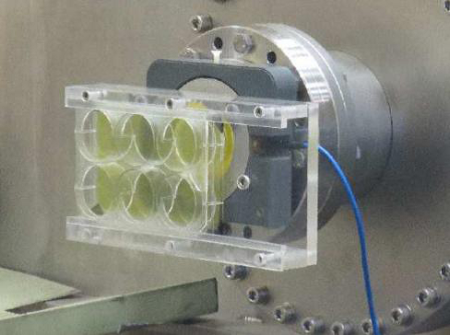Improving Ion Beam-based Cancer Therapy
One of the major advantages of proton or ion beams for cancer treatment is their excellent depth-dose profile exhibiting a low dose in the entrance channel and a distinct dose maximum (Bragg peak) near the end of range in tissue. In the region of the Bragg peak, where the protons or ions are almost stopped, experimental studies with low-energy particle beams and thin biological samples may contribute valuable information on the biological effectiveness in the stopping region.
In a paper that has just been published in the expert journal Physical Review Accelerators and Beams oPAC Fellow Cristina Battaglia and co-researchers present how a beam line has been prepared to get uniform spatial profile irradiation fields of low energy protons. The resulting setup was used to study the dose calibration of radiochromic films for proton energies at which maximum deposition occurs in the active layer. These studies are important to supply an accessible way of measuring dose distributions in proton therapy cancer centers, since color changes in films can be associated to dose measurements.

Irradiation setup for radiochromic films.
Such experiments require beam optimization and special dosimetry techniques for determining the absolute dose and dose homogeneity for very thin biological samples. At the National Centre of Accelerators in Seville, one of the beam lines at the 3 MV Tandem Accelerator was equipped with several elements in order to be able to irradiate cell cultures. In the journal article, which also forms part of a special oPAC edition of the journal, the quantification of the energy deposited by protons is studied with radiochromic films, which have the property of turning blue proportionally to the dose absorbed (fig. 1). The study group successfully obtained results in terms of homogeneity of the beam profile. A protocol of dose calibration for radiochromic films was also established at energies far from the Bragg peak, while effects of saturations were noticed in this region, and further studies will soon be carried out to establish the exact nature of these effects.
Further information:
Dosimetric response of radiochromic films to protons of low energies in the Bragg peak region, M. C. Battaglia, D. Schardt, J. M. Espino, M. I. Gallardo, M. A. Cortés-Giraldo, J. M. Quesada, A. M. Lallena, H. Miras, and D. Guirado, Phys. Rev. Accel. Beams 19, 064701 (2016) – Published 21 June 2016